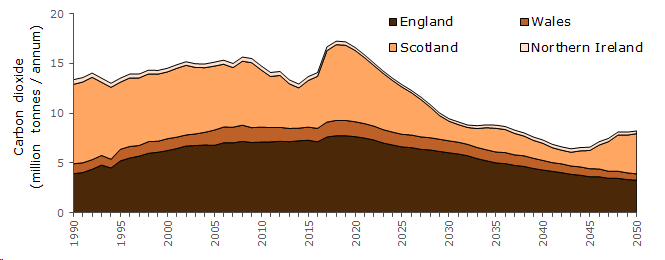In climate change reporting, removals to forestland, also called the forest sink, measures the net annual accumulation of carbon in forests by woody biomass, soils and litter. Table 4.2 and Figure 4.2 show estimates and projections of net carbon dioxide removals attributed to UK forestry, from 1990 to 2050.
The annual rate of accumulation is projected to fall from around 21 million tonnes CO2in total in 2020 to around 10 million tonnes CO2by 2045.
Under the Kyoto protocol, additional woodland planted since 1990 contributes to the UK’s carbon dioxide emissions target; the rate of accumulation of carbon in these new woodlands continues to increase for most of the period as woodland continues to be planted.
Carbon in harvested wood products are not included in the figures shown below (but are included in overall greenhouse gas reporting).
Table 4.2 Net carbon dioxide removals attributed to UK forestry
| Year | In living biomass | Total | of which, due to land afforested since 1990 |
emissions due to land deforested since 1990 |
| million tonnes of carbon dioxide per year | ||||
| 1990 | 13.4 | 18.9 | 0.0 | -0.3 |
| 1995 | 13.5 | 19.6 | 0.2 | -0.3 |
| 2000 | 14.5 | 20.9 | 0.7 | -1.1 |
| 2005 | 15.1 | 21.3 | 1.8 | -1.5 |
| 2010 | 14.8 | 21.0 | 3.4 | -1.4 |
| 2015 | 13.7 | 19.7 | 5.2 | -1.3 |
| 2020 | 16.6 | 21.1 | 6.7 | -1.2 |
| 2025 | 12.9 | 18.5 | 7.8 | -1.1 |
| 2030 | 9.5 | 15.3 | 8.3 | -1.0 |
| 2035 | 8.8 | 13.4 | 8.5 | -0.8 |
| 2040 | 7.3 | 11.5 | 8.0 | -0.6 |
| 2045 | 6.6 | 10.0 | 6.7 | -0.5 |
| 2050 | 8.2 | 10.4 | 5.0 | -0.5 |
Source: Inventory and projections of UK emissions by sources and removal by sinks due to land use, land use change and forestry, produced by the Centre for Ecology and Hydrology (March 2017).
Notes:
1. Net annual accumulation of carbon in forests by woody biomass, soils and litter. Adjusted for losses from deforestation and forest wildfires. Excludes changes in UK harvested wood products.
2. Emissions and sequestration can be presented as tonnes carbon or tonnes carbon dioxide (CO2). To convert from tonnes CO2to tonnes carbon multiply by 12/44.
3. Future predictions of carbon uptake assume that commercial conifer plantations will be replanted when felled, and that planting of new woodland will follow a central projection whereby planting up to 2020 is determined by the available grant for woodland creation (i.e. policy and funding in place), and after that planting rates drop to 10% of the baseline projection, reflecting the lack of funding beyond the current Rural Development Plan.
These figures are outside the scope of National Statistics
Figure 4.2 Net annual change in carbon (CO2equivalent) 1in UK woodlands

Source: Inventory and projections of UK emissions by sources and removal by sinks due to land use, land use change and forestry, produced by the Centre for Ecology and Hydrology (March 2017).
Notes:
1. Net annual accumulation of carbon in living forest biomass only. Adjusted for losses due to deforestation and forest wildfires. Excludes changes in carbon in litter, soils and UK harvested wood products.
2. Emissions and sequestration can be presented as tonnes carbon or tonnes carbon dioxide (CO2). To convert from tonnes CO2to tonnes carbon multiply by 12/44.
3. Future predictions of carbon uptake assume that commercial conifer plantations will be replanted when felled, and that planting of new woodland will follow a central projection whereby planting up to 2020 is determined by the available grant for woodland creation (i.e. policy and funding in place), and after that planting rates drop to 10% of the baseline projection, reflecting the lack of funding beyond the current Rural Development Plan.
These figures are outside the scope of National Statistics.